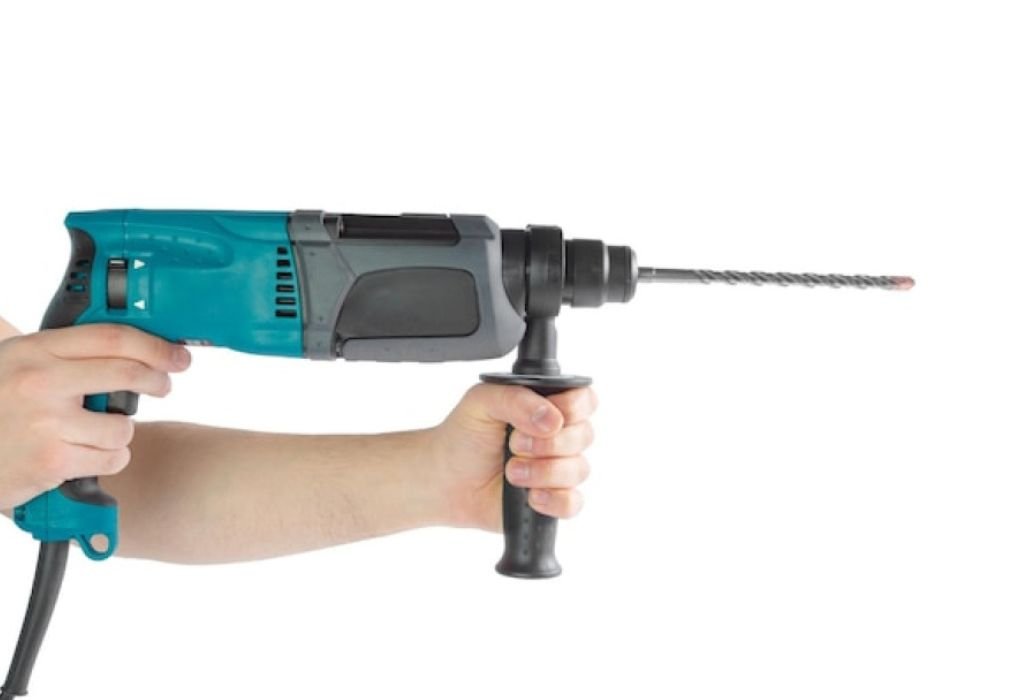A homeowner stands in front of a concrete wall, drill in hand, ready to mount shelves.
The bit spins, dust begins to scatter, but within seconds the tool struggles, overheats, and progress stalls.
This is a common frustration many face when trying to use a regular drill for masonry projects.
The question naturally arises: can a drill really take the place of a rotary hammer?
At first glance, both tools look similar, but their performance in tough materials tells a very different story.
Understanding the distinction can save time, prevent damage, and ensure safety during construction or renovation work.
Drilling into materials like brick, concrete, and stone requires more impact energy than a standard drill can provide.
Rotary hammers are built for such heavy-duty jobs, while traditional drills excel in lighter applications like wood or metal.
Using the wrong tool often leads to broken bits, wasted effort, and even burned-out motors.
The global power tool market reached over $36 billion in 2023 and continues to grow rapidly, with masonry and construction tools representing a major share (source).
This growth highlights how important it is for both DIYers and professionals to choose the right equipment for their tasks.
By exploring the mechanics, applications, and safety considerations of each tool, this article will make clear whether a drill can ever replace a rotary hammer.
The answer depends not only on the material but also on the scope of the project and the long-term durability of the tool.
Understanding the Drill

A standard drill is a versatile tool designed for general household and light construction tasks. It uses rotary motion to cut into materials, making it effective for wood, plastic, and thin metals. Many drills also come with adjustable speed settings, giving users more control.
Cordless drills, in particular, are popular for their portability and ease of use. With modern lithium-ion batteries, they can run for hours before needing a recharge. However, they are still limited in torque and impact energy compared to specialized tools.
Drills often include a hammer function, which delivers a pulsating motion in addition to rotation. While helpful for softer masonry like brick, this feature falls short when tackling reinforced concrete or stone. The motor and gears simply aren’t designed for prolonged impact.
Anyone asking “can I use a drill instead of a rotary hammer” must first understand that while a drill can handle some small masonry tasks, it will rarely match the efficiency or durability of a rotary hammer.
Can a drill go through concrete?
Yes, but only shallow holes in softer concrete, not reinforced structures.
Do all drills have a hammer mode?
No, only hammer drills include that feature, while standard drills do not.
Is a cordless drill strong enough for masonry?
It can handle small brick jobs but struggles with heavy-duty concrete.
Can a drill replace a rotary hammer permanently?
No, drills lack the impact energy and durability required for such tasks.
When should I not use a drill?
Avoid using drills for reinforced concrete, stone, or repeated heavy-duty drilling.
What Makes a Rotary Hammer Different
A rotary hammer is specifically engineered for drilling into hard surfaces. Unlike standard drills, it uses a piston mechanism that delivers far more impact energy per blow. This technology allows the tool to pulverize concrete while simultaneously rotating the bit.
Rotary hammers also use SDS (Slotted Drive System) bits, which lock securely into the chuck. This prevents slippage and transfers maximum force into the drilling surface. Regular drill bits often slip or break under the same conditions.
The design of a rotary hammer prioritizes durability. Stronger motors, reinforced housings, and vibration control systems allow it to withstand prolonged use on construction sites. These tools are built to handle daily work in demanding environments like demolition, concrete anchoring, and rebar penetration.
For those asking can I use a drill instead of a rotary hammer, the answer lies in recognizing the performance gap. While a drill might complete a small job, a rotary hammer is the tool that professionals rely on for consistent results in masonry.
What does SDS mean in rotary hammers?
It refers to the Slotted Drive System that secures bits more firmly.
Is a rotary hammer stronger than a hammer drill?
Yes, it delivers significantly more impact energy per blow.
Can a rotary hammer also chisel?
Yes, many models have a chiseling function for demolition work.
Are rotary hammers only for professionals?
No, homeowners tackling heavy masonry can benefit as well.
Why do rotary hammers cost more?
They are built for durability, high power, and specialized tasks.
Comparing Performance: Drill vs. Rotary Hammer
Performance is where the differences become undeniable. A drill may produce speeds up to 2,000 RPM, but its impact mechanism is weak. By contrast, a rotary hammer produces fewer rotations per minute but delivers far greater impact energy, making it ideal for hard surfaces.
When drilling multiple holes in concrete, a rotary hammer completes the job in minutes compared to the hours a drill might take. This efficiency is critical for contractors who must meet deadlines. Even for DIYers, the reduced effort and cleaner results make a noticeable difference.
Durability is another key factor. Prolonged use of a drill in masonry often leads to overheating, worn gears, or broken bits. Rotary hammers, on the other hand, are designed to absorb the stress of continuous heavy-duty drilling.
The question can I use a drill instead of a rotary hammer is often answered by the scale of the project. For a single small hole, a drill may suffice. For anything larger or repeated, the rotary hammer is the clear winner.
Which tool drills faster into concrete?
A rotary hammer is much faster and more efficient.
Do drills overheat on masonry?
Yes, prolonged drilling can cause overheating and damage.
Can a rotary hammer handle light jobs?
Yes, though it may be considered overkill for wood or metal.
Is the hole quality better with a rotary hammer?
Yes, it produces cleaner, more accurate holes in masonry.
Why is a drill less effective on concrete?
It lacks sufficient impact force to break down dense materials.
When a Drill Can Be Used Instead
There are situations where using a drill instead of a rotary hammer is acceptable. Small tasks, such as hanging picture frames on a brick wall, do not require the power of a rotary hammer. In these cases, a hammer drill or even a standard drill with the right bit can work.
For DIY projects in softer masonry, such as hollow block or mortar, a drill can be a cost-effective solution. With patience and frequent cooling breaks, small holes can be drilled without damaging the tool.
Budget considerations also play a role. Not everyone has access to a rotary hammer, and for occasional light masonry work, purchasing one may not be necessary. Renting a rotary hammer for larger projects is always an option.
However, users must be realistic about expectations. A drill is not designed for repeated heavy-duty use, and forcing it into such tasks will reduce its lifespan.
When can a drill replace a rotary hammer?
For light tasks in brick or mortar with proper bits.
Can masonry bits make a drill stronger?
They help, but they don’t match rotary hammer performance.
Is it safe to use a drill on concrete?
Yes, but avoid reinforced areas and take frequent breaks.
Should I buy a rotary hammer for one job?
Not always—renting is a practical alternative.
How long will a drill last if used on concrete?
Occasional use is fine, but heavy use will shorten its life.
Safety and Best Practices

Safety should never be overlooked when deciding between a drill and a rotary hammer. Both tools generate dust, vibration, and noise that can harm users without protection. Always wear safety glasses, gloves, ear protection, and a dust mask when drilling into masonry.
Proper technique is also essential. Let the tool do the work rather than forcing it. Applying too much pressure can damage the bit or overheat the motor, especially with standard drills.
Using the right bits makes a major difference. SDS bits in rotary hammers are engineered for strength, while carbide-tipped masonry bits improve drill performance. Always check that bits are sharp and undamaged before use.
Finally, consider tool maintenance. Keeping vents clear, cleaning dust buildup, and lubricating moving parts ensure longer life and safer operation.
Do I need PPE when using drills or rotary hammers?
Yes, always use eye, ear, and respiratory protection.
Can forcing a drill make it stronger?
No, it only risks damaging the motor and bit.
Are SDS bits compatible with drills?
No, they are designed specifically for rotary hammers.
How can I reduce dust while drilling?
Use dust extraction systems or water for cooling.
Is vibration a safety concern?
Yes, prolonged vibration can cause fatigue and hand injuries.
Conclusion
So, can you use a drill instead of a rotary hammer? The answer is yes, but only for small, light-duty masonry tasks. For projects involving concrete, stone, or repeated drilling, a rotary hammer is the right tool for the job.
Understanding the strengths and limitations of each tool ensures better results and protects both the user and the equipment. A drill offers convenience and affordability, while a rotary hammer guarantees power and durability.
For homeowners, the decision often comes down to project size and budget. Renting a rotary hammer may be the smartest option for occasional heavy tasks, while keeping a drill for lighter jobs is practical.
By matching the tool to the task, users save time, effort, and money while ensuring safety and long-term success in their projects.

I’m John F. Nicholas, the founder, lead writer, and drill enthusiast behind 101drill.com. With years of hands-on experience in power tools and DIY projects, I created this platform to share practical knowledge, expert tips, and real-world insights to help others master the art of drilling.
